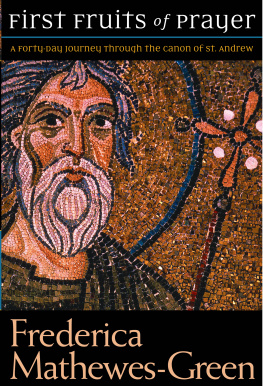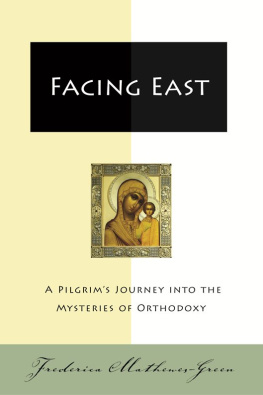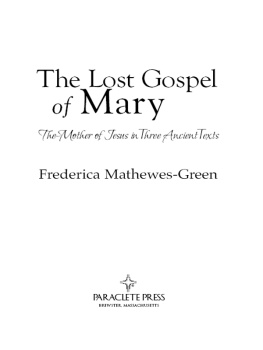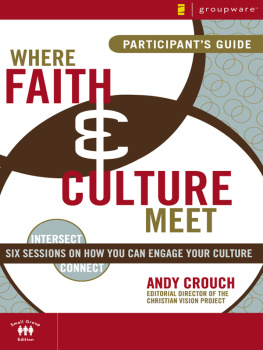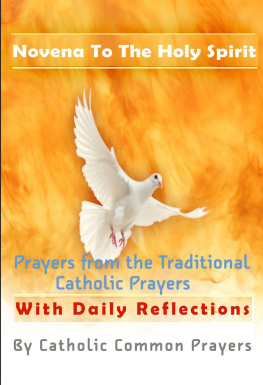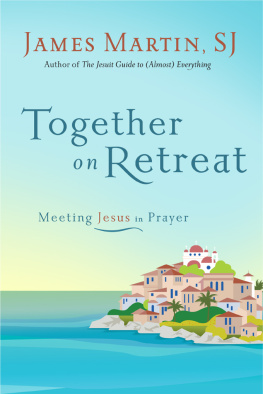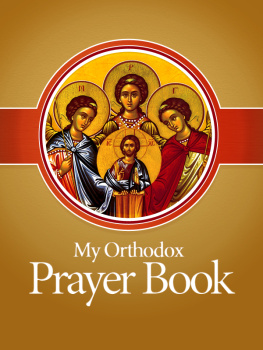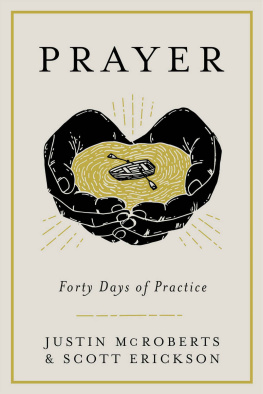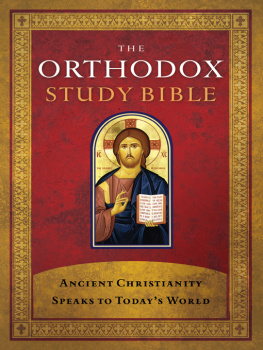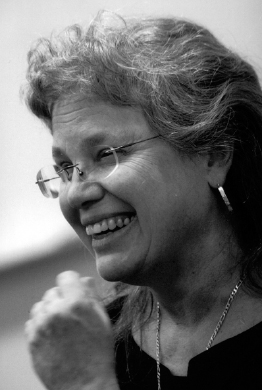Contents
Page List
Guide

Praise for First Fruits of Prayer
First Fruits is a must read for all Christians, especially during Lent. Frederica Mathewes-Green packs an incredible amount of history and spiritual direction into this treasure. In fact, it is one of those I should read this every year books.
Charleston Post and Courier
Looking for a Lenten discipline that will not exhaust your spirit or your timetable? This book offers an eminently doable regimen as well as a freshbut not newoutlook on sin, repentance, and salvation. Because of its insight into a kinder, gentler Christianity in the first millennium, Mathewes-Greens book is a worthwhile read. It provides a refreshing antidote to both the empty feel-good and the fire-and-brimstone religious rhetoric so prevalent today.
The Living Church
The author of several books on Eastern Orthodoxy, Mathewes-Green provides an excellent introduction on the nature of Eastern practices and monasticism.
Catholic News Service
This is powerful reading in every sense. If you want to read something that will challenge you and deepen your relationship with God this Lent, this is the book.
Episcopal Life
Photo: Mary Taber-Lind
Frederica Mathewes-Green is a popular speaker, award-winning author, columnist for Beliefnet.com, and the Khouria (spiritual mother) of Holy Cross Orthodox Church near Baltimore, Maryland. Her other books include The Illumined Heart: Capture the Vibrant Faith of Ancient Christians; The Open Door: Entering the Sanctuary of Icons and Prayer; and The Lost Gospel of Mary: The Mother of Jesus in Three Ancient Texts. Visit her on the Web at www.frederica.com.
First Fruits of PRAYER
A Forty-Day Journey Through the Canon of St. Andrew
FREDERICA MATHEWES-GREEN
First Fruits of Prayer
2008First Paperback Printing
2006First Hardcover Printing
Copyright 2006 by Frederica Mathewes-Green
ISBN 978-1-55725-611-9
Unless otherwise indicated, all Scripture quotations are taken from the Revised Standard Version of the Bible, copyright 1952 [2nd edition, 1971] by the Division of Christian Education of the National Council of the Churches of Christ in the United States of America. Used by permission. All rights reserved.
Quotations from the Septuagint appearing on pages 32 and 126 are taken from The Septuagint with Apocrypha: Greek and English by Sir Lancelot C. L. Brenton: Peabody, MA: Hendrickson Publishers, 1986. First published London, 1851.
The Library of Congress has catalogued the hardcover edition as follows: Mathewes-Green, Frederica.
First fruits of prayer: a forty-day Journey through the Canon of St. Andrew / Frederica Mathewes-Green.
p. cm.
ISBN 1-55725-469-9
1. Andrew of Crete, Saint, ca. 660-740. Megas Kanon 2. Spiritual lifeOrthodox Eastern Church. 3. RepentanceOrthodox Eastern Church. 4. Devotional exercises. I. Andrew of Crete, Saint, ca. 660-740. Megas Kanon.
English. 2006. II. Title.
BX375.A6M38 2006
264.019013dc22
2005023957
10 9 8 7 6 5 4 3 2 1
All rights reserved. No portion of this book may be reproduced, stored in an electronic retrieval system, or transmitted in any form or by any meanselectronic, mechanical, photocopy, recording, or any otherexcept for brief quotations in printed reviews, without the prior permission of the publisher.
Published by Paraclete Press
Brewster, Massachusetts
www.paracletepress.com
Printed in the United States of America
To Bishop Kallistos Ware of Diokleia, with gratitude.
Contents
Introduction
What is the Canon of St. Andrew?
The Great Canon of St. Andrew of Crete is a prayerful hymn of epic length, which is offered in a Lenten worship service every year in the Eastern Orthodox Church. It was written by St. Andrew, a leading figure of early Christian hymnography. He was born in Damascus, spent his early years as a monk in Jerusalem, then went to serve orphans and the elderly in Constantinople. Eventually he was made bishop of Crete, and died in AD 740.
St. Andrew built up his Canon from a very close examination of the Scriptures, primarily the Old Testament. As he considered each passage he took to heart the events and characters there, looking for lessons for his own life and urging himself to love God more completely. The work is very personal in tone, and St. Andrew may have written it for his own private use. As it became known throughout the Church it was taken up broadly, and has been used during every Lent since in the Eastern Church.
The Canon is not a mere historical curiosity, however. Many contemporary Christians have the sense that believers in the early centuries had a different experience of the faith than we customarily do todaymore intense, more rich, and frankly, more challenging. The key was the kind of rigorous self-examination St. Andrew shows us here: a whole-hearted embrace of repentance as a path to self-knowledge and healing, and eventually to union with God. We are not used to thinking of repentance as a positive tool anymore, or as something that would continue to accompany a Christian throughout a lifetime. As we walk alongside St. Andrew, and see him search the Scriptures, and hear his humility matched by grateful confidence in Gods compassion, we begin to glimpse the healing power of repentance.
How Should I Use This Book?
The Great Canon is divided into nine sections, or canticles. But for purposes of this book it has been rearranged into forty readings, one for each day of a self-directed retreat. Lent, of course, is an ideal time to enter this spiritual resource, but it could be used any time you want to deepen and challenge your faith.
Each reading is accompanied by a verse-by-verse commentary that will provide the Scriptures cited by St. Andrew and further explore the meaning of the passage. This running commentary, headed Explore, is found on the page facing the corresponding passage of the Canon.
In each chapter, following the passage of the Canon and the Explore commentary, you will find a few paragraphs headed Consider. These brief meditations will provide further thoughts about the themes raised in that days reading, and provide questions to stir up deeper reflection.
If you have wished you could pray like the Desert Fathers did, or read Scripture like the church fathers did, or know God like the early martyrs did, the Great Canon can be a doorway. It can take you back in time to the early centuries of Christian worship, and open the way to a prayerfulness that is not bound by time at all.
The Spiritual Background of the Canon
THINGS CHANGED. The Lord Jesus Christ, who calls people to Himself today as He has for thousands of years, never changes. But the encounter with Him that we sense in our hearts is met by things we learn from the outsideinformation gained from Scriptures and pastors and teachers of the faith. There are also general expectations that prevail in our worshiping community, as well as some expectations of the larger society about what religious faith is and does.

